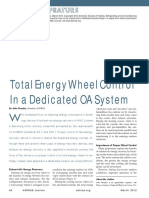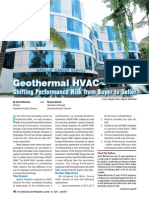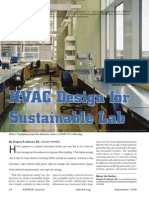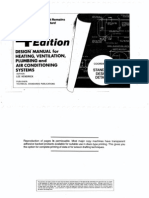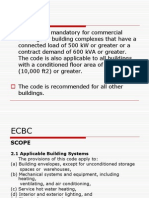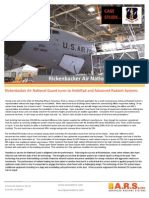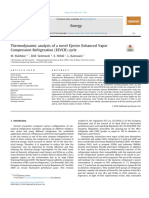Engineering: Energy Recovery
Engineering: Energy Recovery
Uploaded by
SuchitKCopyright:
Available Formats
Engineering: Energy Recovery
Engineering: Energy Recovery
Uploaded by
SuchitKOriginal Title
Copyright
Available Formats
Share this document
Did you find this document useful?
Is this content inappropriate?
Copyright:
Available Formats
Engineering: Energy Recovery
Engineering: Energy Recovery
Uploaded by
SuchitKCopyright:
Available Formats
Edition No.
July 2001
ENGINEERING
S Y S T E M S O L U T I O N S
n this issue, we provide background information on various energy recovery devices, as well as several considerations for determining whether or not energy recovery is right for your application. While they have been around for several years, energy recovery devices have generally been used in applications with high minimum outdoor air requirements. Given the savings they can generate amd rising cost of energy, it makes good sense to consider using an energy recovery device in less demanding applications. At McQuay, we take pride in providing engineered products that can give you flexibility to build the exact HVAC systems you need for optimum energy efficiency, good indoor air quality, low sound and low cost installation and service. Our second article introduces our latest innovations: factory-installed and tested energy recovery options available in McQuay Vision air handlers and Roofpak applied rooftop systems and rooftop air handlers.
Energy Recovery
Is It The Right Choice For Your Application?
Maintaining acceptable indoor air quality is generally accomplished by introducing ventilation air from outdoors. But bringing in more outside air costs money because the air must be conditioned to match the indoor space requirements. In many applications such as schools, the ventilation load can represent over 30% of the cooling load and 50% of the heating load. ASHRAE Standard 90.1-1999 states that Individual fan systems that have both a design supply air capacity of 5,000 cfm or greater and have a minimum outside air supply of 70% or greater shall have an energy recovery system with at least 50% recovery effectiveness (Section 6.3.6.1). While this requirement is generally meant to apply to 100% outside air systems, a strong case could be made for using energy recovery in less demanding applications. latent energy provides the added benefit of significantly raising the humidity of the outdoor air in the winter and lowering it in the summer. This can have a dramatic impact on the first cost and operating cost of the HVAC system. Mechanical humidification requires 1,100 Btu per pound of humidity and can contribute to significantly higher operating costs. Mechanical dehumidification generally requires overcooling the supply air stream and (in many cases) reheating it, again contributing to higher operating costs. Examples of enthalpy devices include enthalpy wheels and permeable membrane exchangers. Table 1 provides an overview of various devices. For more information, refer to the 2000 ASHRAE Systems and Equipment Handbook, Chapter 44.
Continued on next page.
You can find this and other issues of Engineering Systems Solutions on our website at www.mcquay.com. Also, check out our Whats New page for information and literature on McQuay and other McQuay products. McQuay provides semi-custom system solutions for commercial HVAC applications. This newsletter is written specifically for the HVAC engineering community. We welcome your comments, feedback, and article suggestions. Hugh Crowther Director of Applications McQuay North America
Energy Recovery Types
There are two basic types of air-to-air energy recovery equipment; sensible devices and enthalpy devices (or total energy devices). Sensible devices transfer sensible energy (or heat) from the return air stream to the supply air stream. The heat raises the incoming outdoor air temperature in the winter and lowers it in the summer. Energy savings result from the reduced need for mechanical heating or cooling. Examples include plate heat exchangers, runaround loops, sensible wheels and heat pipe heat exchangers. Enthalpy devices transfer both sensible energy and moisture (latent energy). The
IN THIS ISSUE
Introduction. . . . . . . . . . . . . 1 Energy Recovery Is It The Right Choice For Your Application? . . . . . 1 McQuay Offers Energy Recovery Equipment . . . . . . 4
Table 1 - Energy Recovery Devices
8 a.m. to 5 p.m. in a year. With the weather and hours known, the ventilation load and credit from the energy recovery device can be calculated. Figure 1 shows the airstream conventions for a typical energy recovery device.
Figure 1. Airstream Conventions.
ASHRAE Standard 84, Method of Testing Air-to-Air Heat Exchangers, defines effectiveness of energy recovery devices as follows: wsa(xsa-xoa) wea(xra- xea) = w = wmin(xra-xoa) min(xra-xoa) Where; is effectiveness Xxa is humidity ratio, dry bulb temperature or enthalpy at the given location wsa is supply air mass flow rate wea is return air mass flow rate wmin is smaller of wsa and wea With this equation, Bin weather data and indoor design conditions, it is possible to model how an energy recovery device will operate. The calculations are performed for every Bin and then extended for the year by multiplying by the number of occurrences in that Bin. The following is a list of some of the relationships that occur in energy recovery devices: It is misleading to assume that a sensible device will only transfer sensible energy. If this assumption is made, then it would be tempting to use the equation Qs=1.085*cfm*(T2-T1). Consider a heat pipe (a sensible device) where there is a humidification in the space. At certain design conditions, the humidity in the return air will condense on the heatpipe and that latent energy will be transferred to the supply air stream as sensible energy. If only sensible energy transfer is considered, then the actual energy transfer will be underestimated. (Figure 2) The equation above is based on mass flow rate (lb/hr) rather than volume flow rate (cfm). Energy transfer is a function of mass flow rate. If the density is known, then it is easy to convert to volume flow rate. The problem is that as the
Copyright 2000, American Society of Heating, Refrigerating and Air-Conditioning Engineers, Inc. www.ashrae.org. Images reprinted by permission from ASHRAE 2000 Handbook-HVAC Systems and Equipment.
Economic Analysis
To evaluate whether energy recovery is right for your application, the capital cost and operating cost savings must be estimated.
consulting engineers choose not to do so to provide proper ventilation if the energy recovery device is not functioning. The credit for downsizing the cooling and dehumidification equipment can often offset the increased cost of the return air ductwork. In this case, the cost to add an enthalpy device is the capital expense of the device and controls associated with it. A sensible device will not generate as much of a credit for downsizing the cooling or dehumidification equipment.
Capital Cost
The following capital expenses should be considered for including an energy recovery device: The capital cost of the energy recovery device. The cost associated with upsizing fan motors to account for any static pressure drop differences. The cost associated with upsizing the return air ductwork to account for the required purge volume when using enthalpy wheels. The cost savings associated with downsizing humidifiers when using enthalpy wheels. The cost savings associated with downsizing the cooling system for enthalpy wheels. While the heating system could also be downsized, many
Operating Cost
Estimating operating costs is an involved process and requires the aid of a computer. Since the load on the energy recovery system is based on the ambient weather, using Bin analysis is a good option for simplifying the calculations. Bin hours are the number of hours that the outdoor temperature is within a certain temperature range. This can further be divided into certain time periods during the day. For instance, Chicago, Illinois spends 383 hours between 35F and 40F during the hours of
Figure 2. Sensible Energy Recovery With Condensation
One of the big advantages of enthalpy recovery devices is they transfer moisture as well as sensible heat. By transferring moisture from the exhaust air stream, they lower the humidity ratio and avoid frosting. It is not unusual for an enthalpy wheel to have exhaust air temperatures below 20F without frosting.
condition should be calculated, supply air conditions of 80F db/67F wb are typical.
Sample Operating Cost Analysis
Table 2 provides a sample of calculations performed for a school in the Chicago area. The following design parameters were used:
temperature of the air changes, its density changes. If volume flow rates (cfms) are used, the question quickly becomes volume at what temperature? Total energy devices are passive desiccant systems. Water molecules are removed from one air stream by adsorption. The water molecules leave the desiccant and are reabsorbed into another airstream if the partial pressure is low enough. The equation for this takes the same form as the equation on the previous page but with the enthalpy factors replaced by humidity ratios (lbs water/lb air). Relative humidities cannot be used in the equation. The sensible energy transfer in an enthalpy wheel is accomplished by the wheel itself absorbing the heat in one air stream and transferring it to another. (Figure 3)
Figure 3. Heat Recovery Process During Winter Heat
Enthalpy Wheel Process Sensible Process Frost is likely to occur in the exhaust of a sensible energy recover device
Humidification has been linked to improved IAQ. Humidification also Occupancy 8am to 5pm improves the operation of many electronic devices by lowering the Ventilation requirement 14,000 cfm possibility of static electricity. However, Exhaust requirement 11,750 cfm humidification is very expensive. Poorly Summer space conditions 75F, 50% RH designed and/or operated humidification systems can be significant IAQ liabilities, Winter space conditions 72F, 30% RH (humidification because standing water and wet surfaces required) create an opportunity for Table 2. Sample Calculations microbial growth. Because Ventilation Load No Device Sensible Enthalpy Device Device enthalpy systems can (Heat Pipe) (Heat Wheel) reduce the humidity load Heating (Mbtu/year) 1,230,000 508,700 507,400 by 60 to 70% , they offer significant operating and Cooling (Mbtu/year) 268,400 204,000 110,600 first cost savings. In 225,000 92,800 Humidification (pounds/year) 225,000 addition, desiccant-based The most noticeable result from Table 2 is moisture transfer devices do not have any the significant load reduction by wet surfaces, so they reduce the introducing an energy recovery device. In likelihood of microbial growth. particular, the data shows that an Enthalpy The winter temperature difference Device can provide close to a 60% credit in between outdoor air and indoor air (For the heating, cooling and humidification example 75F indoors load. The Sensible Device provides a 32F outdoors) provides an significant credit in the heating load, but excellent driver for sensible has significantly less impact on the cooling energy transfer in cold and humidification loads. These figures can climates. However, in the be translated into operating cost savings to summer the drybulb provide simple payback or other financial temperature difference is analyses. For more information on quite small. Sensible calculating the ventilation credit for a energy transfer devices Amount of sensible or enthalpy device, contact your have a very limited effect recovered local McQuay representative. moisture on outdoor air during summer periods. Further, once dewpoint has been reached, the latent energy absorbed in the outdoor air stream must be released as sensible energy on the exhaust air stream. Typically, sensible devices only lower the outdoor air temperature to about the dewpoint. While the sensible temperature difference is small in the summer, the humidity ratio between the indoor and outdoor air is very large. This enables a enthalpy device to remove a significant amount of latent energy from the outdoor air. Further, the supply air does not have to first reach dewpoint to remove the moisture. Although the supply air
added to outdoor air supply
Conclusion
Given the rising cost of energy, the uncertainty surrounding deregulation and its effect on energy costs and availability, it makes sense to consider using an energy recovery device. While the analysis is somewhat involved, the results can demonstrate significant year-over-year operating cost savings. This, in turn, can go a long way towards justifying any up front costs or additional operating costs associated with adding an energy recovery device. In addition, adding an energy recovery device may qualify for rebate dollars with your local gas or electric supplier, further offsetting the cost of the equipment.
Frosting can occur whenever the exhaust air stream is near 100% RH and the temperature is below 32F. In colder climates, this occurs frequently and some form of frost control is required. Whatever the energy transfer rate is at the time the frost control commences will be the steady state energy transfer rate for that outdoor air temperature or colder. Not allowing for this will result in the actual performance of the energy device being overestimated. It should be noted that the stated effectiveness for energy recovery devices does not take into account frosting.
McQuay Offers Energy Recovery Equipment
Energy recovery equipment is available in McQuay Vision air handlers and Roofpak applied rooftop systems and rooftop air handlers. The equipment is preengineered, factoryinstalled and tested to reduce design and installation costs, and for reliable startup. Options for Vision air handlers include runaround coil loops, rotary wheel and fixed plate energy exchangers. Published independent test data that verifies performance against the complete ASHRAE Standard 84-1991 Method of Testing Air-To-Air Heat Exchangers are available for the rotary wheel and fixed plate energy exchanger products used in McQuay Vision air handlers. McQuay RoofPak applied rooftop systems and rooftop air handlers can now be equipped with an ARI Certified enthalpy wheel to provide sensible and latent energy recovery. The enthalpy wheel is fully integrated with McQuay MicroTech II DDC controls to effectively minimize defrost time, properly control outdoor air, return air and exhaust air and to provide bypass damper control as needed. For more information on McQuay energy recovery equipment options, contact your local McQuay Representative.
For comments or suggestions, please call or write: Chris Sackrison, Editor McQuay International 13600 Industrial Park Boulevard Minneapolis, MN 55441 Phone: (763) 553-5419 E-mail: chris.sackrison@mcquay.com For more information on McQuay products and services, or to speak with your local representative, call (800) 432-1342, or visit our web page at www.mcquay.com. 2001 McQuay International
You might also like
- PFD Nitric Acid Dan Pid PDFDocument9 pagesPFD Nitric Acid Dan Pid PDFasriNo ratings yet
- Chiller Maintenance Procedure PDFDocument4 pagesChiller Maintenance Procedure PDFMd. Yusuf100% (1)
- ISOStandardDocument3 pagesISOStandardlady soto chNo ratings yet
- Total Energy Wheel Control in A Dedicated OA System: by John Murphy, Member ASHRAEDocument9 pagesTotal Energy Wheel Control in A Dedicated OA System: by John Murphy, Member ASHRAEJose GallegosNo ratings yet
- Geothermal HVAC: Shifting Performance Risk From Buyer To SellerDocument5 pagesGeothermal HVAC: Shifting Performance Risk From Buyer To SellerKagitha TirumalaNo ratings yet
- HVAC Design For Sustainable Lab: by Gregory R. Johnson, P.E., Member ASHRAEDocument11 pagesHVAC Design For Sustainable Lab: by Gregory R. Johnson, P.E., Member ASHRAEAu NguyenNo ratings yet
- EST HighRiseBuildingSystemsDocument4 pagesEST HighRiseBuildingSystemsmpwasaNo ratings yet
- How Do You Convert BTU To CFM?Document6 pagesHow Do You Convert BTU To CFM?sanjay975No ratings yet
- HVAC Chapters 1 5Document57 pagesHVAC Chapters 1 5Mcilwaine Dela CruzNo ratings yet
- Cooling Load Estimation For Hibir BoatDocument10 pagesCooling Load Estimation For Hibir BoatAdi WahyudiNo ratings yet
- Tear Cooling Tower Energy Operating Cost SoftwareDocument9 pagesTear Cooling Tower Energy Operating Cost Softwareforevertay2000No ratings yet
- Steam Management (Spirax Sarco)Document31 pagesSteam Management (Spirax Sarco)Heru PramudyaNo ratings yet
- Standard Design Details KapitolineDocument359 pagesStandard Design Details KapitolineMohamed100% (3)
- HVAC Cold Air DistributionDocument21 pagesHVAC Cold Air DistributionPhanhai KakaNo ratings yet
- High Latent Cooling Load Applications (Low RSHF)Document17 pagesHigh Latent Cooling Load Applications (Low RSHF)f 3No ratings yet
- Unit 3 XX Passive CoolingDocument109 pagesUnit 3 XX Passive CoolingShamreen RoofinaNo ratings yet
- Dr. Fixit Newcoat 105 1 PDFDocument3 pagesDr. Fixit Newcoat 105 1 PDFmohdrashidNo ratings yet
- Chiller - An OverviewDocument21 pagesChiller - An OverviewDtl SarozNo ratings yet
- Chilled BeamsDocument1 pageChilled BeamsrkibNo ratings yet
- Adiabatic MixingDocument33 pagesAdiabatic MixingSurya Kiran KNo ratings yet
- EN - 45-4 - AHRI 920-Rating Standard For DX Dedicated Outdoor-Air Units PDFDocument8 pagesEN - 45-4 - AHRI 920-Rating Standard For DX Dedicated Outdoor-Air Units PDFTonyChuangNo ratings yet
- Air System Sizing Summary For BELOW GROUND FLOORDocument9 pagesAir System Sizing Summary For BELOW GROUND FLOORSameera LakmalNo ratings yet
- Engineering Bulletin CDQ Desiccant DehumidificationDocument28 pagesEngineering Bulletin CDQ Desiccant DehumidificationsdvitkoNo ratings yet
- Example Fahu VFDDocument6 pagesExample Fahu VFDpradeepdonNo ratings yet
- ASHRAE Journal - VAVR Vs ACB+DOAS PDFDocument12 pagesASHRAE Journal - VAVR Vs ACB+DOAS PDFmlamourNo ratings yet
- Faculty of Engineering TechnologyDocument11 pagesFaculty of Engineering TechnologyRidzwan IqbalNo ratings yet
- What Is The Basis For Fan SelectionDocument3 pagesWhat Is The Basis For Fan SelectionsmcsamindaNo ratings yet
- Stair Pressurisation Zone Smoke Control SystemsDocument24 pagesStair Pressurisation Zone Smoke Control SystemsAshokNo ratings yet
- Optimizing Central Chilled Water SystemsDocument56 pagesOptimizing Central Chilled Water Systemsapi-328841994No ratings yet
- Proper Engine Room VentilationDocument2 pagesProper Engine Room VentilationAsok AyyappanNo ratings yet
- تقرير تدريب صيفي لواء الدين مظفرDocument23 pagesتقرير تدريب صيفي لواء الدين مظفرlalaNo ratings yet
- ASHRAE - Series Series Counterflow For Central Chilled Water PlantsDocument7 pagesASHRAE - Series Series Counterflow For Central Chilled Water PlantsAntonio LebrunNo ratings yet
- Technical Specification of DuctDocument3 pagesTechnical Specification of DuctmishtinilNo ratings yet
- Heat Recovery From Industrial Compressed Air SystemsDocument4 pagesHeat Recovery From Industrial Compressed Air SystemsmawooaNo ratings yet
- Boiler Pumps Fans Sizing CalculationsDocument4 pagesBoiler Pumps Fans Sizing CalculationsFarrahxviiiNo ratings yet
- ECBC BEE-Hotel CapitolDocument31 pagesECBC BEE-Hotel CapitolrsahayNo ratings yet
- Skills Workshop: For Condensing BoilersDocument3 pagesSkills Workshop: For Condensing BoilersKailas NimbalkarNo ratings yet
- Elec Floor Heating HandbookDocument60 pagesElec Floor Heating HandbookNavanee KrishnanNo ratings yet
- Ngineering ATA: Temperature & Altitude Effects On FansDocument3 pagesNgineering ATA: Temperature & Altitude Effects On FansMohamed TahounNo ratings yet
- Humidity ControlDocument16 pagesHumidity ControlHanan SFNo ratings yet
- The Basics of Heating, Ventilation and Air ConditioningDocument33 pagesThe Basics of Heating, Ventilation and Air ConditioningDaryan HoshangNo ratings yet
- TraneDocument8 pagesTraneLuis CarlosNo ratings yet
- Biddle - VRVDocument31 pagesBiddle - VRVutzu_yooNo ratings yet
- Solar Dessicant Air Conditioning PosterDocument1 pageSolar Dessicant Air Conditioning PosterAmit PrakashNo ratings yet
- RAC 32 Important QuestionDocument10 pagesRAC 32 Important QuestionBalvinderNo ratings yet
- Heat Exchanger - WaterCoilDocument115 pagesHeat Exchanger - WaterCoilPrem KumarNo ratings yet
- Chilled Water PipingDocument6 pagesChilled Water Pipingunicornmep100% (1)
- 10-An - Swimming Pool Dehumidifier SizingDocument4 pages10-An - Swimming Pool Dehumidifier SizingalzyoudNo ratings yet
- Heat Wheel: Mohammad Yusuf 13PKB380Document10 pagesHeat Wheel: Mohammad Yusuf 13PKB380Haider Ali100% (1)
- ACR-News: Masterclass: Psychometrics - Part 28Document5 pagesACR-News: Masterclass: Psychometrics - Part 28streamtNo ratings yet
- TC Fundamentals 2011 PsychrometricsDocument57 pagesTC Fundamentals 2011 PsychrometricsTapas ChaudhuriNo ratings yet
- Hvac PG DiplomaDocument5 pagesHvac PG DiplomaThava SelvanNo ratings yet
- 10 Tips To Improving Chiller EfficiencyDocument3 pages10 Tips To Improving Chiller Efficiencygraemesquires85100% (1)
- Circuit Setter Valve Balance Procedure: Technical ManualDocument36 pagesCircuit Setter Valve Balance Procedure: Technical ManualEmrah aliçayNo ratings yet
- Psychromoist User GuideDocument10 pagesPsychromoist User GuidePawan SehrawatNo ratings yet
- Fans and Blowers PDFDocument129 pagesFans and Blowers PDFJap IbeNo ratings yet
- 2016 HVAC Systems SelectionDocument2 pages2016 HVAC Systems SelectionActiveNo ratings yet
- A Guide in Practical Psychrometrics for Students and EngineersFrom EverandA Guide in Practical Psychrometrics for Students and EngineersNo ratings yet
- Epa Bum Ch9 HvacDocument23 pagesEpa Bum Ch9 Hvaccesar luis gonzalez rodriguezNo ratings yet
- Heating, Cooling ChillerDocument23 pagesHeating, Cooling ChillerMyo TuntheinNo ratings yet
- 3 Simple WaysDocument7 pages3 Simple WaysAruna Prasanna DewasurendraNo ratings yet
- L 2 1 C: B P: e R V A LDocument8 pagesL 2 1 C: B P: e R V A LChesa LumaguiNo ratings yet
- Optimization of Energy Plants Including Water/lithium Bromide Absorption ChillersDocument23 pagesOptimization of Energy Plants Including Water/lithium Bromide Absorption ChillersIgor Maciel O. SilvaNo ratings yet
- Schedule of Grilles and Diffusers: Project: S.M.R.C DohaDocument4 pagesSchedule of Grilles and Diffusers: Project: S.M.R.C DohaSuchitKNo ratings yet
- FIDICDocument10 pagesFIDICSuchitKNo ratings yet
- 2-Nd Floor Bell-B Pressure Area Served by SL - No: Space Number Space Name Air Terminal Device Referance Supply AirDocument20 pages2-Nd Floor Bell-B Pressure Area Served by SL - No: Space Number Space Name Air Terminal Device Referance Supply AirSuchitKNo ratings yet
- Heater BatteryDocument1 pageHeater BatterySuchitKNo ratings yet
- 1st-Fahu-01 SPCDocument1 page1st-Fahu-01 SPCMohammad IsmailNo ratings yet
- AAF - ChevroNet - Filters CatalogueDocument2 pagesAAF - ChevroNet - Filters CatalogueSAGL100% (1)
- Air-Conditioning Design For Medical BuildingsDocument45 pagesAir-Conditioning Design For Medical BuildingsCristobal TardoNo ratings yet
- Thermostat STC-9200 User Manual - 2021 UpdateDocument2 pagesThermostat STC-9200 User Manual - 2021 UpdateHaswill ElectronicsNo ratings yet
- Fan Selection Total PressureDocument4 pagesFan Selection Total PressureWONG TSNo ratings yet
- 2.hydronic System PDFDocument17 pages2.hydronic System PDFtonylyfNo ratings yet
- McQuay MDB Data Sheet Eng1Document1 pageMcQuay MDB Data Sheet Eng1Saeful Malik GintingNo ratings yet
- Engineering Design Guidelines Refrigeration Systems Rev02webDocument24 pagesEngineering Design Guidelines Refrigeration Systems Rev02webkarlitox123No ratings yet
- F T A C R S: INE Uning IR Onditioning AND Efrigeration YstemsDocument6 pagesF T A C R S: INE Uning IR Onditioning AND Efrigeration YstemsAbdul RahmanNo ratings yet
- Installation ManualDocument120 pagesInstallation ManualAmyt SrivastavNo ratings yet
- Rickenbacker Air National GuardDocument1 pageRickenbacker Air National GuardWhitney DavisNo ratings yet
- Selecting Air Conditioners For EnclosureDocument7 pagesSelecting Air Conditioners For EnclosureErdinc KlimaNo ratings yet
- PACU Series: Rooftop Packaged Air ConditionersDocument17 pagesPACU Series: Rooftop Packaged Air ConditionersOmair FarooqNo ratings yet
- CU Discus CopelandDocument4 pagesCU Discus Copelandahmed sanirNo ratings yet
- Thermodynamic Analysis of A Novel Ejector Enhanced Vaporcompression Refrigeration (EEVCR) CycleDocument14 pagesThermodynamic Analysis of A Novel Ejector Enhanced Vaporcompression Refrigeration (EEVCR) Cyclembt2004No ratings yet
- 267-280 TCRDA Members SecunderabadDocument14 pages267-280 TCRDA Members SecunderabadAthish KumarNo ratings yet
- Sez Kd18 OperationmanualDocument36 pagesSez Kd18 Operationmanualzvn99No ratings yet
- Hvac CalculationDocument15 pagesHvac CalculationArt JamesNo ratings yet
- Ac Ice Formation CausesDocument2 pagesAc Ice Formation CausesGanesh KumarNo ratings yet
- Homework - Mechanical SpecificationDocument2 pagesHomework - Mechanical SpecificationJose Rowell MacabantiNo ratings yet
- Bry Air Nsmail-96-1Document2 pagesBry Air Nsmail-96-1Ravi BhargavaNo ratings yet
- كرولا Manual - Inspection - Air conditioning system - Heater & air conditionerDocument5 pagesكرولا Manual - Inspection - Air conditioning system - Heater & air conditionerBashir MtwaklNo ratings yet
- Carel Refrigerant Scenario 2024 Whitepaper EngDocument36 pagesCarel Refrigerant Scenario 2024 Whitepaper EngRoger AklNo ratings yet
- Ventilation Systems Cost ComparisonsDocument5 pagesVentilation Systems Cost ComparisonsMartinNo ratings yet
- Racc Two MarksDocument11 pagesRacc Two Marksvishweshwar vishwaNo ratings yet
- Cucbo CatalogueDocument12 pagesCucbo CatalogueThuan TaNo ratings yet
- DBR of Ventilation System 162Document10 pagesDBR of Ventilation System 162pukhrajsoniNo ratings yet



